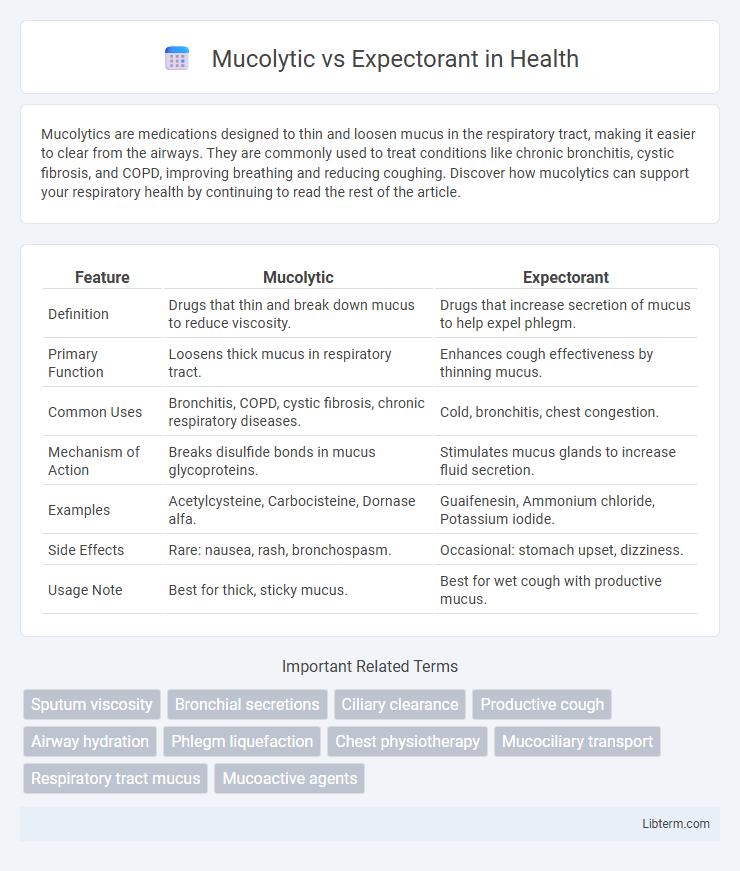Mucolytics are medications designed to thin and loosen mucus in the respiratory tract, making it easier to clear from the airways. They are commonly used to treat conditions like chronic bronchitis, cystic fibrosis, and COPD, improving breathing and reducing coughing. Discover how mucolytics can support your respiratory health by continuing to read the rest of the article.
Table of Comparison
| Feature | Mucolytic | Expectorant |
|---|---|---|
| Definition | Drugs that thin and break down mucus to reduce viscosity. | Drugs that increase secretion of mucus to help expel phlegm. |
| Primary Function | Loosens thick mucus in respiratory tract. | Enhances cough effectiveness by thinning mucus. |
| Common Uses | Bronchitis, COPD, cystic fibrosis, chronic respiratory diseases. | Cold, bronchitis, chest congestion. |
| Mechanism of Action | Breaks disulfide bonds in mucus glycoproteins. | Stimulates mucus glands to increase fluid secretion. |
| Examples | Acetylcysteine, Carbocisteine, Dornase alfa. | Guaifenesin, Ammonium chloride, Potassium iodide. |
| Side Effects | Rare: nausea, rash, bronchospasm. | Occasional: stomach upset, dizziness. |
| Usage Note | Best for thick, sticky mucus. | Best for wet cough with productive mucus. |
Understanding Mucolytics and Expectorants
Mucolytics work by breaking down the chemical structure of mucus, reducing its viscosity and making it easier to expel from the respiratory tract. Expectorants increase the production and hydration of mucus, facilitating a more productive cough to clear airways. Both agents improve respiratory function but target mucus properties differently, with mucolytics thinning mucus and expectorants enhancing mucus clearance.
How Mucolytics Work: Mechanism and Benefits
Mucolytics work by breaking down the structure of mucus molecules, reducing their viscosity and making the mucus thinner and easier to expel from the respiratory tract. By targeting the mucopolysaccharide fibers that give mucus its thickness, mucolytics enhance mucus clearance, improving airway patency and reducing symptoms associated with chronic bronchitis, cystic fibrosis, and other respiratory conditions. This mechanism facilitates better oxygen exchange and helps prevent infections caused by mucus buildup.
Expectorants Explained: Action and Uses
Expectorants increase the hydration of respiratory secretions, thinning mucus to facilitate easier coughing and clearance from the airways. They stimulate the mucous glands, promoting the expulsion of phlegm in conditions like bronchitis, common colds, and other respiratory tract infections. Guaifenesin is a widely used expectorant effective in reducing chest congestion and improving breathing by loosening mucus.
Key Differences Between Mucolytics and Expectorants
Mucolytics thin and break down the chemical structure of mucus, making it less viscous and easier to expel from the respiratory tract, while expectorants increase the hydration of secretions, promoting the production of thinner mucus to facilitate coughing. Mucolytics like acetylcysteine act on the mucus itself to reduce its thickness, whereas expectorants such as guaifenesin stimulate the mucus glands to enhance clearance. The primary difference lies in the mode of action: mucolytics chemically degrade mucus, whereas expectorants increase fluid secretion to loosen mucus.
Common Mucolytic Medications
Common mucolytic medications include acetylcysteine, carbocisteine, and ambroxol, which work by breaking down the chemical structure of mucus, reducing its viscosity and facilitating easier expectoration. These agents are often used in chronic respiratory conditions like chronic bronchitis, COPD, and cystic fibrosis to improve airway clearance and reduce mucus obstruction. Unlike expectorants that stimulate mucus production, mucolytics directly target mucus consistency, making them essential in managing thick and tenacious secretions.
Popular Expectorant Drugs
Popular expectorant drugs, such as guaifenesin, enhance mucus clearance by thinning secretions and facilitating productive coughing. Unlike mucolytics, which chemically break down mucus to reduce its viscosity, expectorants stimulate the respiratory tract to increase fluid secretion and promote expectoration. Common brands containing guaifenesin include Mucinex and Robitussin Chest Congestion, widely used to relieve chest congestion in respiratory conditions.
Indications: When to Use Mucolytics or Expectorants
Mucolytics are indicated for patients with thick, viscous mucus that is difficult to clear, such as in chronic bronchitis, cystic fibrosis, and chronic obstructive pulmonary disease (COPD), where breaking down mucus viscosity aids in expectoration. Expectorants are primarily used to increase bronchial secretion hydration, making mucus less tenacious and easier to expel in conditions like acute bronchitis, common cold, and upper respiratory tract infections. Selecting mucolytics or expectorants depends on mucus characteristics and underlying respiratory conditions to optimize airway clearance and symptom relief.
Potential Side Effects and Precautions
Mucolytics, such as acetylcysteine, can cause side effects including nausea, vomiting, and rarely bronchospasm, requiring caution in patients with asthma or respiratory hypersensitivity. Expectorants like guaifenesin might lead to gastrointestinal discomfort or rash, prompting users to avoid excessive doses and ensure adequate hydration. Both classes should be used carefully in individuals with chronic respiratory conditions, and medical advice is recommended if symptoms persist or worsen.
Choosing the Right Therapy for Cough and Mucus
Mucolytics thin and break down mucus, making it easier to clear from the respiratory tract, ideal for thick, sticky mucus conditions like chronic bronchitis or cystic fibrosis. Expectorants increase the hydration of mucus, facilitating its expulsion by coughing, and are effective in treating productive coughs with more fluid secretions. Selecting the right therapy depends on mucus consistency and underlying respiratory conditions, with mucolytics suited for dense mucus and expectorants beneficial when promoting mucus clearance is the primary goal.
Frequently Asked Questions About Mucolytics vs Expectorants
Mucolytics work by breaking down the chemical structure of mucus, making it thinner and easier to expel, while expectorants increase the hydration of airway secretions to facilitate mucus clearance. Common questions about mucolytics vs expectorants often address their effectiveness in treating respiratory conditions like bronchitis and chronic obstructive pulmonary disease (COPD), as well as their safety profiles and potential side effects. Patients frequently ask which option is more suitable for persistent coughs with thick mucus and how these medications can be combined with other treatments for optimal respiratory health.
Mucolytic Infographic

 libterm.com
libterm.com